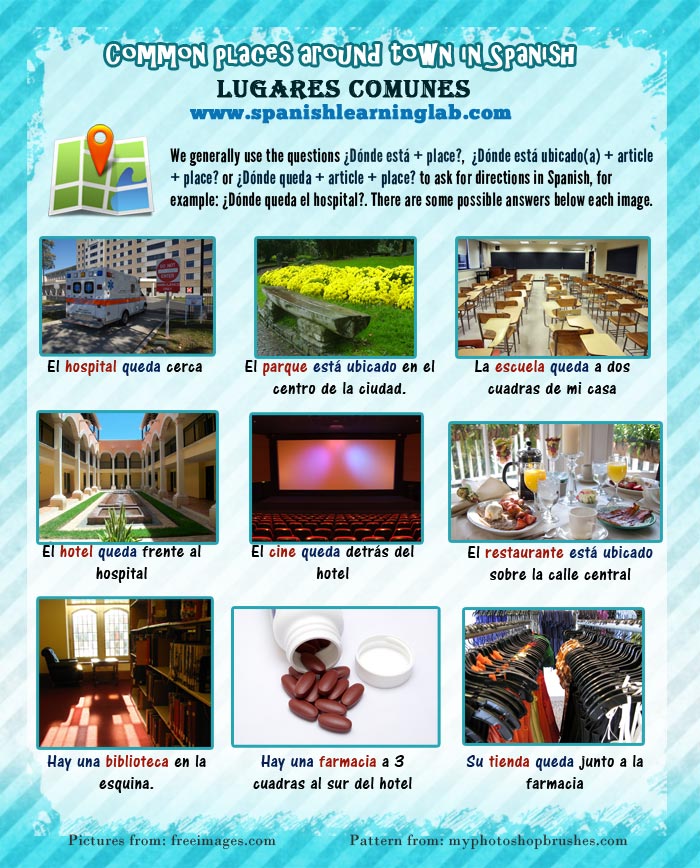
Getting around a new town and asking directions of places may be tricky sometimes. A good way to start is by learn the names of common places in town in Spanish, and the way to give basic directions in Spanish too. This lesson will introduce the vocabulary for places in Spanish through a list of sentences about location and activities people do in the places they visit. Let’s start…
We will begin this lesson with a picture showing some common places in town in Spanish. The picture also includes some of the ways to ask for and give directions in Spanish that we will discuss in this lesson. For now, please focus on the names of these places in Spanish and associate them with places you have gone to in your city before. Then try solving the vocabulary quiz. Also, pay attention to the examples of sentences with places in Spanish in the picture.

Before we move on to the audio examples in this lesson, we will discuss how to make simple sentences with places in Spanish, especially to ask for and give directions in Spanish.
In order to ask for directions to places in Spanish, we will often use the verbs ESTAR/QUEDAR (to be) and HABER in its form HAY (there is/there are). ESTAR will be used in its forms ESTÁ and ESTÁN following this sentence structure:
¿Dónde + ESTÁ/ESTÁN (ubicado) + definite article + place?
Some examples following this pattern are: ¿Dónde está el hospital? and ¿Dónde están ubicados los hoteles? The word UBICADO (located) is optional. QUEDAR is used in the forms QUEDA and QUEDAN following the same structure for ESTAR, e.g. ¿Dónde queda la farmacia? and ¿Dónde quedan los hoteles? Last we have the verb HAY, which is used with indefinite articles UN, UNA instead of definite articles like EL or LA, for example: ¿Dónde hay un banco? and ¿Dónde hay un parque?. Here are two more examples with audio for you to check the pronunciation of these questions.
¿Dónde está ubicada la panadería? Where is the bakery? ¿Sabes dónde queda el banco? Do you know where the bank is?Those are the questions for directions in Spanish, but how do we answer? We can easily give directions with ESTAR, QUEDAR and HABER. For the verbs ESTAR and QUEDAR, the sentences usually follow the structure below:
Article (el, la, las, los) + place (lugar) + verb + preposition + article + place of reference.
e.g. “Los hoteles quedan sobre la avenida central” and “La farmacia está junto a la tienda”
For HAY we follow a different grammatical structure so instead of definite articles, we will use indefinite articles (un, una…):
Hay + indefinite article + place (lugar) + direction
e.g. Hay una tienda junto al hotel and “Hay una farmacia junto a la tienda “
Notice that prepositions of place like JUNTO A, FRENTE A and EN are very useful when asking for or giving directions in Spanish so make sure you understand how to use them. Also, know that the word CUADRA (block) is used to measure a 100 meters distance and you can say the distance in Spanish from one place to another with the phrase [ESTAR/QUEDAR A + distance + DE + place of reference], for example: “El restaurante está a 3 cuadras de la gasolinera” or using a specific distance “La biblioteca está a 200 metros del cafetín”. Listen to some examples of directions to places in town in Spanish and try to find out other hidden details.
ESCUELA – La escuela está en la esquina de esta calle. The school is on the corner of the street ESTACIÓN DE BUSES – La estación de buses está ubicada junto al supermercado. The bus station is located next to the supermarket BIBLIOTECA – La biblioteca estaba ubicada detrás del supermercado. The library was behind the supermarket SUPERMERCADO – El supermercado queda en el norte de la ciudad. The supermarket is on the north side of the city JOYERÍA – La joyería queda a dos cuadras al sur de la escuela. The jewelry store is two blocks south of the school HOTEL – Los hoteles quedan sobre la avenida central. The hotels are on the main avenue TIENDA – Hay una tienda de ropa cerca de la ferretería. There is a clothing store near the hardware storeThe last group of examples will be using verbs like VER, IR, DETENER, COMER, ESTAR y QUEDAR in the past tense in Spanish. Explaining the rules to conjugate verbs in the past tense in Spanish is out of the scope of this lesson. Basically, these verbs will be used in sentences with places in Spanish like “Fuimos al parque” (We went to the park) and “Comimos en el restaurante” (We ate at the restaurant). The main point is that when talking about any topic in Spanish you may need different tenses. When you see expressions such as ANOCHE, AYER, LA SEMANA PASADA and others then you will know we are talking about past events.
Affirmative sentences will follow the structure [Subject + reflexive pronoun + verb + complement] like in the sentences “Nosotros nos detuvimos en una gasolinera anoche” and “Ellos comieron en ese restaurante el lunes pasado”. Negative sentences follow the same structure, with the difference that we add the word NO before the conjugated verb like in the sentence “Ellos no fueron al hospital”. Here are a few more examples with places in Spanish and verbs in the past tense. Check the translation provided to see which verb is being used in the example.